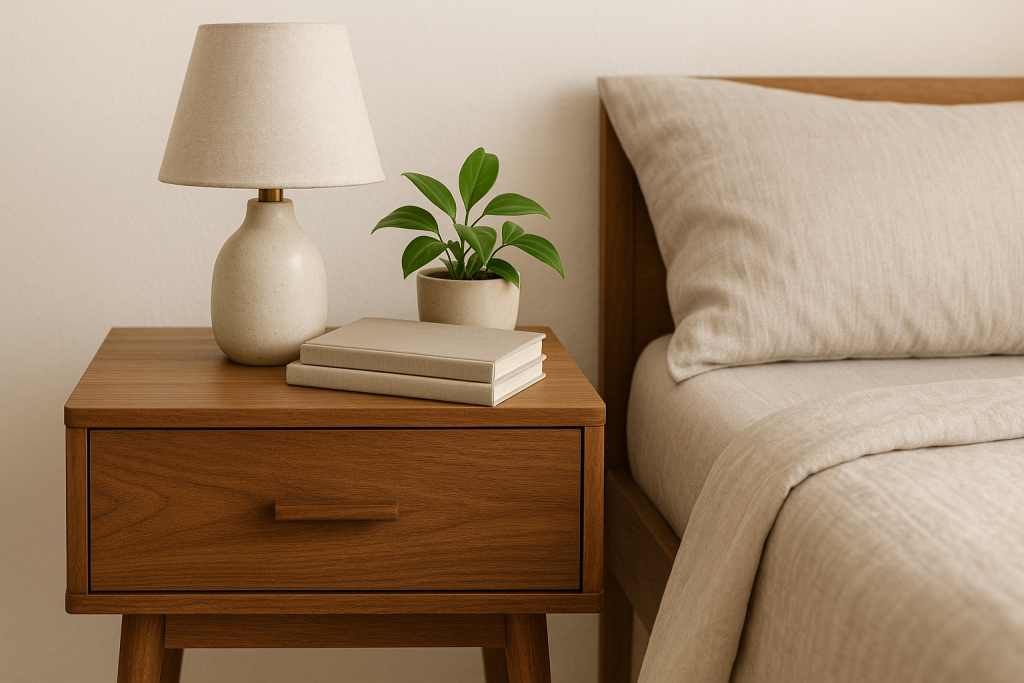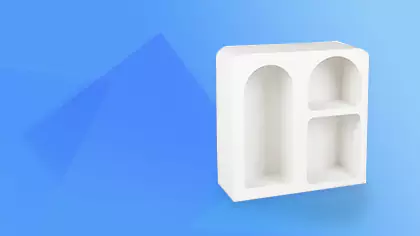Your bedroom is your sanctuary, the one place where comfort and personal style should reign supreme. And while the bed may be the star of the show, the humble nightstand is its most crucial supporting actor. A great wood nightstand does more than just hold your lamp and phone; it anchors your bed, provides essential storage, and adds a layer of warmth and texture that can transform the entire room.
If you’re looking to elevate your bedside, a modern wood nightstand is a timeless choice that blends natural beauty with clean, contemporary design. But with so many styles, woods, and features available, how do you find the perfect one? Consider this your ultimate guide. We’ll explore everything from popular hardwoods to the latest trends, ensuring you find a wooden bedside table that’s not just beautiful, but perfectly suited to your life.
Why Choose Wood for a Modern Nightstand?
In a world filled with metal, glass, and high-gloss lacquer, wood holds a special appeal. It’s a choice that connects us to nature and brings an organic, grounding element into our most personal space.
- Unmatched Warmth: Unlike colder materials, wood has an inherent warmth. The rich grain of walnut or the light, airy feel of oak can make a bedroom feel more inviting and serene.
- Durability and Longevity: A solid wood nightstand is an investment. Properly cared for, hardwoods can last for generations, developing a beautiful patina over time. They are sturdy, reliable, and forgive minor bumps and scrapes far better than more fragile materials.
- Versatile Style: Wood is a master chameleon. A sleek oak nightstand can feel distinctly Scandinavian, while a tapered-leg walnut piece screams mid-century modern. Wood pairs beautifully with other materials, complementing metal lamps, soft linen bedding, and ceramic accessories with ease.

Decoding the Wood: Popular Hardwood Types
The type of wood you choose defines the character of your nightstand. Each has a unique look, feel, and price point.
- Oak: Known for its prominent grain and exceptional durability, oak is a classic choice. White oak offers a light, neutral, and contemporary look popular in Scandinavian and minimalist designs. Red oak has a warmer, more traditional feel. It’s a mid-range hardwood that resists scratches and wear exceptionally well.
- Walnut: If you’re seeking drama and sophistication, look no further than walnut. Its rich, dark chocolate tones and smooth, often straight grain create a luxurious and moody feel. It’s the signature wood of mid-century design and makes a stunning statement piece. As a premium hardwood, it sits at a higher price point.
- Teak: Prized for its incredible durability and natural resistance to moisture, teak boasts a beautiful golden-brown hue that deepens over time. Its high oil content gives it a natural luster. While often associated with outdoor furniture, its resilience and warm color make it a fantastic, albeit pricey, choice for a high-end wooden bedside table.
- Maple: Light in color with a subtle, fine grain, maple offers a clean, bright, and understated look. It’s incredibly strong and dense, making it resistant to dents. Its smooth surface is perfect for a minimalist aesthetic and can be stained to match other furniture, though its natural pale beauty is its main draw.
Finding Your Style: Modern Design Trends
“Modern” isn’t a single look; it’s an umbrella for several distinct styles. Which one speaks to you?
Scandinavian Simplicity
The scandinavian style wood nightstand is all about clean lines, functionality, and a celebration of natural materials. Think light-colored woods like oak or ash, simple forms (often just a box with legs or a single drawer), and a lack of ornamentation. The focus is on creating a bright, airy, and uncluttered space.
Mid-Century Modern Charm
The iconic mid-century nightstand is defined by its organic shapes and signature details. Key features include:
- Tapered, angled legs that give it a light, floating appearance.
- Rich, warm woods, especially walnut and teak.
- Clean, unadorned drawer fronts, often with minimalist brass or carved wood pulls. This style is perfect for adding a touch of retro sophistication and character. For instance, a piece like “The Walden,” a classic mid-century nightstand in solid walnut with a single drawer and an open lower shelf, typically ranges from $350 to $600 and offers both style and function.
Floating and Wall-Mounted
For the ultimate minimalist look or for a small bedroom, a floating wood nightstand is a brilliant solution. Mounted directly to the wall, it frees up floor space, making the room feel larger and easier to clean. It provides a sleek, architectural platform for your essentials—a design that’s both visually light and highly practical.
See our full article on Choosing a Maple Nightstand? 7 Things You Need to Know First.
More Than Just Looks: Key Features to Consider
A nightstand is a workhorse. Before you buy, think about what you need it to do.
- Storage: Drawers or Shelves? Drawers are perfect for hiding clutter—charging cables, hand cream, and that book you’re halfway through. Open shelves, on the other hand, offer easy access and a place to display curated items. Many designs offer a combination of both.
- Smart Tech: In 2025, a nightstand with USB ports and built-in outlets is less a luxury and more a necessity. Look for models with integrated charging stations or clever cable management systems to keep your cords tidy and out of sight.
- Hardware Details: Soft-close glides on drawers are a small detail that makes a huge difference—no more jarring slams in the middle of the night. The quality of the pulls (be they metal, wood, or leather) also contributes to the overall look and feel.
- Size and Height: Scale is everything. Your nightstand should be proportionate to your bed. A good rule of thumb is that the top surface should be roughly level with the top of your mattress, typically between 24 and 28 inches high. For a king-size bed, choose a wider nightstand (or a pair) to avoid it looking dwarfed.
What’s Trending in 2025?
While classic designs are always in, a few new trends are making waves and adding fresh texture to modern wood nightstands.
- Fluted and Reeded Fronts: Vertical grooves on drawer fronts add stunning texture and shadow play.
- Curves and Arches: Soft, rounded edges and arched legs are replacing some of the stricter lines of years past, adding a gentle, organic feel.
- Mixed Materials: Think a wood frame with a stone top, cane or rattan drawer fronts, or delicate metal legs.
- Spool Legs: A playful, traditional detail (also known as bobbin or Jenny Lind legs) is being reinterpreted in modern contexts for a touch of whimsical charm.
- Waterfall Edges: A single piece of plywood or solid wood appears to “waterfall” over the side, creating a continuous grain and a seamless, high-design look.
Real-Life Scenarios: Finding the Right Fit
- For Small Spaces: The best hardwood nightstand for a small bedroom is one that doesn’t eat up visual or physical space. A wall-mounted floating wood nightstand in light oak is an ideal choice. It offers a surface and storage without any footprint. A single-leg pedestal table is another great space-saver.
- For the Power Couple: In a primary bedroom, a matching pair of nightstands creates symmetry and balance. Opt for designs with at least two drawers each to provide ample personal storage and keep the shared space tidy.
- For the Luxury Seeker: A large, statement nightstand in a premium wood like walnut or teak with high-end hardware, a marble top, or built-in lighting can serve as a piece of functional art.
- For the Minimalist: A simple cube of solid wood or a clean, open-shelf design provides just enough function without any fuss. The beauty of the wood grain itself becomes the main feature.
Buying & Maintenance Tips: Your Long-Term Investment
Choosing a quality piece means it will look great for years. Here’s what to look for.
Solid Wood vs. Veneer
A solid wood nightstand is made entirely from planks of hardwood. It’s heavy, extremely durable, and can be sanded and refinished if it gets damaged. Wood veneer consists of a thin layer of real hardwood glued to a core of a more stable, less expensive material like MDF or particleboard.
Don’t dismiss veneer! High-quality veneer is very durable, less prone to warping or cracking in dry climates than solid wood, and can make beautiful, expensive woods more accessible. The key is “high-quality.” Look for well-finished edges and a solid core.
How to Care for Your Wood Nightstand
- Use Coasters: Always. Water rings are the enemy of a beautiful wood finish.
- Dust Regularly: Use a soft, dry microfiber cloth to avoid scratching the surface.
- Avoid Direct Sunlight: UV rays can fade and damage the wood finish over time.
- Keep it Away from Heat: Don’t place your nightstand directly against a radiator or heating vent, as extreme temperature changes can cause wood to warp or crack.
Read our complete guide on caring for solid wood furniture.
The Final Word
Choosing a modern wood nightstand is about finding the perfect intersection of your personal style and your daily needs. It’s an opportunity to add a piece of lasting, natural beauty to your bedroom that will serve you faithfully every night and every morning. Whether you fall for the clean lines of a Scandinavian design, the retro cool of a mid-century nightstand, or the space-saving genius of a floating shelf, the right piece is out there.
Take your time, consider the materials, and think about the features that will make your life easier. Your perfect wooden bedside table is waiting to complete your sanctuary.











